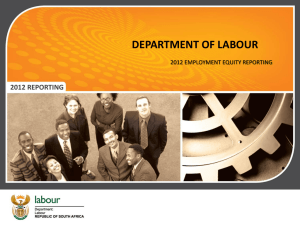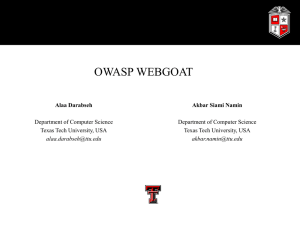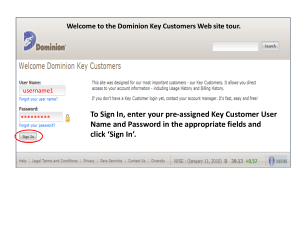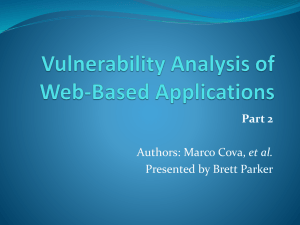Lab 3 - OpenSecurityTraining.info
advertisement
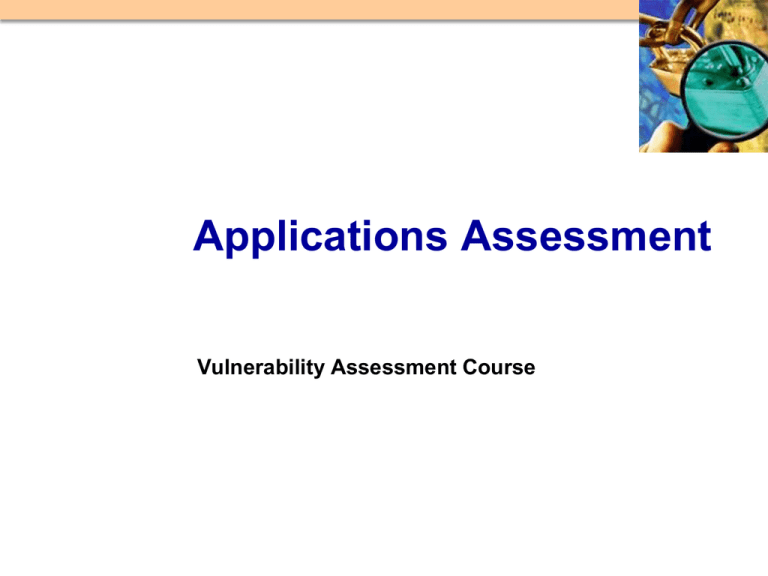
Applications Assessment Vulnerability Assessment Course All materials are licensed under a Creative Commons “Share Alike” license. ■ http://creativecommons.org/licenses/by-sa/3.0/ 2 Agenda ■ Introduction ■ Application – what is it? Why do we care? ■ Assessment preparations ■ Application assessment tools ■ Application Vulnerabilities ■ Lab: Spider and scan a Web application 3 Some Assumptions ■ This is just the starting point – an introduction ■ Not all risks discussed ■ Application testing is hard and time consuming ■ We can't cover everything ■ Not here to debate terminology 4 The Problem ■ You have applications… ■ Your applications have weaknesses!! ■ How do you know what weaknesses they contain? ■ Application vulnerability assessment will help you find them… 5 Applications ■ Distinguish from system/infrastructure ■ Provide business logic to support functionality of/for an organization – Enterprise level ■ Examples may include accounting, personnel, payroll – Department level ■ Examples may include resource management, information management 6 Understanding Each Other 7 Application Vulnerabilities ■ Unauthenticated or unauthorized access – Viewing – Modifying – Deleting ■ Failure to enforce security controls – Secure communication – Password length, complexity, age, history – Least privilege – Session management, lockout, termination – Hard-coded or default password – Inactive, temporary, training, test, demo accounts – Input validation Pretty simple, right? 8 Application Attack Vectors ■ Parameter manipulation ■ Script and SQL injection ■ Session management ■ Interception ■ Malware ■ Buffer overflow houseofhackers.ning.com/profile/whatitry All found in the CWE/SANS Top 25 Programming Errors 9 The Result 10 Some Things to Ponder ■ Looking at and using the application in ways a "normal" user would not – Exposes weaknesses – Bad guys don’t follow rules – Problems due to unintentional user actions ■ Use the expected client environment...but also try "unexpected" environments ■ Phased application implementation ■ Assessment location ■ How long should it take? 11 Caveats ■ Production versus development environments – Potential to modify production data – In some cases production is preferable – Advantages of manual testing over automated tools ■ Impact of specific testing ■ Development or test systems that mimic production ■ Some testing can only be performed in production 12 Methodology ■ Phase 1 – Planning ■ Phase 2 – Information Collection ■ Phase 3 – Enumeration ■ Phase 4 – Testing and Evaluation ■ Phase 5 – Reporting 13 Required Information ■ Business description of the application – Purpose/function – business rules – Types of information – Types of Users/Roles ■ Users and their locations ■ Technical description – All methods of access – Site URLs as applicable – Application Account(s) ■ All roles, including administrator/super user – Data flow/transaction logic/use cases 14 Application Familiarization ■ What is the application’s purpose? – What does the application evaluator know about the business processes? ■ Who are its users? – Are there various user roles with distinctive privileges? ■ How is it accessed? ■ What are the underlying technologies? Remember me? What is most important? What, if not working properly, would cause major problems? What are the critical functions? 15 16 17 Basic Tools – Yours or The System Owner’s ■ Web Browser ■ Application Proxy ■ Network Protocol Analyzer Tools are not THE solution! They don’t understand business logic and produce false positives… 18 Additional Online Tools ■ Google Hacking – Using Google to search publicly accessible Web applications for vulnerabilities and to discover sensitive information ■ site:<webapp> filetype:doc (try other file extensions too) ● Example: site:yahoo.com filetype:xls ■ Netcraft – http://www.netcraft.com/ ■ Wayback Machine – http://www.archive.org/ 19 Methodology ■ Phase 1 – Planning ■ Phase 2 – Information Collection ■ Phase 3 – Enumeration ■ Phase 4 – Testing and Evaluation ■ Phase 5 – Reporting 20 Application Mapping ■ Now that you have your hands on the application, you *really* get to see what's what ■ Discover application functionality – Identify channels for user input – Identify implemented security controls – Determine where critical data resides – “Reality" doesn't always match the documentation – Lack of or incomplete documentation 21 Methodology ■ Phase 1 – Planning ■ Phase 2 – Information Collection ■ Phase 3 – Enumeration ■ Phase 4 – Testing and Evaluation ■ Phase 5 – Reporting 22 Information Exposures – Hidden Functionality 23 Malicious File Uploads ■ Web applications that accept file uploads may present Trojan or directory traversal vulnerabilities – Type of file should be restricted to only those required – Text is the only safe file type left 24 Account Lockout and Session Inactivity ■ Account Lockout – Number of failed attempts – Length of lockout – Client-side processing – Automatic lockout for unused account ■ Termination of session due to inactivity or logout 25 Force Errors in the Application ■ Errors can reveal application weaknesses 26 Authentication Issues ■ Length ■ Complexity – Dictionary words ■ History ■ Aging – Minimum days – Maximum days ■ Error messages ■ Client-side processing ■ Hard-coded passwords 27 Change User Passwords ■ Attempt to substitute parameters that are passed from the client to the server when a password change is made ■ Attempt to reset passwords by guessing answers to easy “security” questions ■ Account enumeration ■ Published technique ■ Login error messages ■ Brute force 28 Session State ■ A chain of trust ■ HTTP is a stateless protocol, therefore Web servers respond to client requests without coupling them together ■ Valid Session token exposure may permit a malicious user to take over the session ■ Session Exercise 29 Data Transmission Confidentiality ■ Protecting data in transit – Application data – Session tokens 30 Business Logic and Workflows ■ Validate Business Logic ■ Hardest risk to detect…application walk-through helps ■ Cannot be detected by vulnerability scanners ■ Assumptions by developers…requires creative thinking – Parameter manipulation – Perform steps 1, 2, 3 in order, what happens if step 2 is skipped – Level=1, role=user, etc – http://<testurl>/admin/ or http://<testurl>/pwdchange/ ■ Impact examples – Horizontal and vertical role escalation – Unauthorized process flows What is most important? What, if not working properly, would cause major problems? What are the critical functions? 31 Input Validation ■ Lack of input validation results in code insertion via user supplied data ■ Caused when… – User input incorrectly filtered can result in executed code – User input is not strongly typed and thereby unexpectedly executed ■ User input cannot be trusted ■ Client-side validation inadequate 32 Cross Site Scripting (XSS) ■ Code injection attack into the various interpreters in the Web browser – HTML, JavaScript, VBScript, ActiveX, Flash, etc. ■ Types – Persistent – Non-Persistent ■ Used for… – Account hijacking – Changing user settings – Cookie theft/poisoning – Denial of Service – Scanning for vulnerabilities 33 SQL Injection HTTP SQL response query HTTP request DB Table Database Application Code "SELECT * FROM Account Summary Account: accounts WHERE Acct:5424-6066-2134-4334 SKU: SKU: acct=‘’ OR 1=1-Acct:4128-7574-3921-0192 ’" Acct:5424-9383-2039-4029 Acct:4128-0004-1234-0293 1. Application presents a form to the attacker 2. Attacker sends SQL code in the form data App Server Web Server Firewall Firewall Hardened OS 3. Application forwards code to the database in a SQL query 4. Database runs query containing attack code and sends results back to application 5. Application sends results to the attacker Derived from OWASP AppSec DC 2009 presentation by Dave Wichers 34 Lab 1 and 2 – Hidden Information ■ Getting started – Open Student Windows VM … password is “guest” – Click “WebGoat Server” – Open “WebGoat User” – Log in as "guest" ... password is “guest” ■ Lab 1 – Instructor Guided – Code Quality … Discover Clues in the HTML ■ Lab 2 – Instructor Guided – Parameter Tampering … Exploit Hidden Fields 35 Lab 3 – Web Application Tools ■ Getting started – Open Student Windows VM … password is “guest” – Click “WebGoat Server” – Open “WebGoat User” – Log in as "guest" ... password is “guest” – Open Paros ■ Lab 3 – Instructor Guided – Use Paros to spider WebGoat, then scan 36 Questions 37

